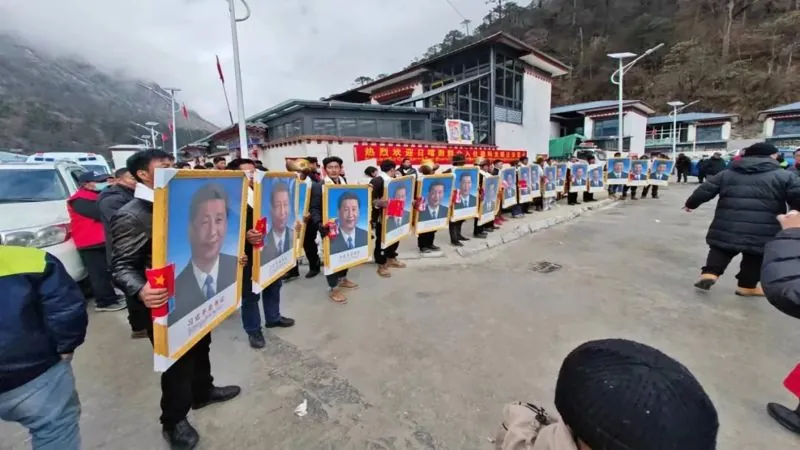
Tensions Rise as China Constructs Controversial Villages Near Bhutan Border
2024-11-05
Author: Chun
Introduction
In the towering heights of the Himalayas, a new reality unfolds as China embarks on ambitious construction projects that are stirring significant controversy. Nestled in the picturesque valleys, uniform Tibetan-style houses, all adorned with the Chinese flag, are sprouting up, signaling a bold move by the Chinese government.
Geopolitical Implications
Recent reports have revealed a construction frenzy in a previously isolated area, with various building materials lining the roads and cranes towering over new housing developments. The village in question, Demalong, was officially established in March 2022, initially housing about 70 families. Yet, this venture has drawn the ire of neighboring Bhutan, as the area is claimed under Bhutanese territory according to their official maps—creating a flashpoint of geopolitical tensions.
Historical Context
For centuries, this rugged land served primarily as summer pasture for nomadic herders; however, the Chinese government has been enticing settlers from Tibet to establish a more permanent presence. As the Chinese state strengthens its control over border regions, this trend is seen as part of a broader strategy by President Xi Jinping to secure national interests and reinforce territorial claims, not just in the Himalayan region, but also extending to the South and East China Seas.
China-Bhutan Relations
The historical backdrop of China-Bhutan relations is fraught with complexity and unresolved border disputes. Despite ongoing dialogues for decades, Bhutan remains cautious amid China's assertiveness, with neighboring India—Bhutan’s closest ally—keeping a watchful eye on developments. Recently, India's military disengagement agreements with China highlight the sensitive nature of these tensions, revealing that the situation remains precarious not only between China and Bhutan but also among these three nations.
Satellite Imagery and Developments
Satellite imagery obtained by CNN shows extensive development in a valley referred to as Jigenong by China and Jakarlung in Tibetan. A detailed examination of this construction effort involved experts who identified several villages built or in the process of being constructed, bringing into question the legitimacy of Chinese claims in the area that Bhutan regards as sovereign territory.
Responses from Bhutan and China
While the Bhutanese government denies that Chinese settlements have invaded their claimed area, insisting that the maps of their northern boundary will be finalized in accordance with ongoing negotiations, the reality on the ground tells a different story. China’s foreign ministry argues that these developments are aimed at boosting the livelihoods of local populations, claiming that discussions with Bhutan are ongoing to address the territorial claims.
Historical Tensions
As tensions flared in 2017 over reported Chinese encroachment in the Doklam area—a strategic point shared by China, India, and Bhutan—the current developments suggest a renewed focus by China on asserting its territorial integrity. Notably, these areas serve as crucial conduits for trade and security interests for all three nations involved.
Construction and Strategic Implications
China's construction efforts have not been limited to seamless housing; they've included roads designed to connect sprawling new settlements, despite experts noting the lack of direct links to Bhutan’s existing infrastructure. The allure of these new villages, built under the banner of "border xiaokang" or "moderate prosperity" initiatives, comes with the caveat of underlying strategic aims to establish human presence in disputed territories.
Criticism and Concerns
Reports indicate that the framework surrounding these constructions escalates year-on-year, with more than 600 new villages constructed in Tibet alone, contributing to an increase in border population. Critics argue that these moves are not just philanthropic but rather calculated strategies by China to strengthen its hold in regions it claims, using civilian settlements as a pretext for military presence.
Bhutan's Diplomatic Position
This situation is complicated further by the differing narratives and diplomatic nuances between Bhutan and China. The Bhutanese diplomatic stance has become more ambiguous, possibly hinting at an unspoken accord regarding territorial claims. Meanwhile, experts speculate that Bhutan, facing an uphill battle against its powerful neighbor, may be adopting a wait-and-see approach while nurturing relations with China to enhance economic prospects.
Conclusion
As construction continues and the geopolitical landscape evolves, the ramifications of such establishments will be vital to watch—they not only threaten the delicate balance of Bhutan’s territorial integrity but also highlight the intricate web of regional politics involving China, Bhutan, and India. In summary, while the picturesque Himalayan surroundings offer a stunning backdrop, the escalating tensions from China's construction efforts in disputed territories signal a fundamental shift in the geopolitical dynamics of the region. As both nations navigate their claims and aspirations, this silent conflict in the heights of the Himalayas becomes a pivotal point of concern that could reshape future relations.


 Brasil (PT)
Brasil (PT)
 Canada (EN)
Canada (EN)
 Chile (ES)
Chile (ES)
 España (ES)
España (ES)
 France (FR)
France (FR)
 Hong Kong (EN)
Hong Kong (EN)
 Italia (IT)
Italia (IT)
 日本 (JA)
日本 (JA)
 Magyarország (HU)
Magyarország (HU)
 Norge (NO)
Norge (NO)
 Polska (PL)
Polska (PL)
 Schweiz (DE)
Schweiz (DE)
 Singapore (EN)
Singapore (EN)
 Sverige (SV)
Sverige (SV)
 Suomi (FI)
Suomi (FI)
 Türkiye (TR)
Türkiye (TR)